Paul Kilfoil became addicted to travelling after his first trip to Europe in 1987. Since then he has been to every continent except Antarctica, mostly on his own but more recently with his wife (Karen) and son (Scott, 15 years old in 2011). He started blogging his travels in 2001, long before the word “blog” was a familiar term. A software developer by profession, Paul tries to balance his working life with as much leisure and travelling as possible. He counts himself lucky to live in one of the most beautiful cities on Earth – Cape Town in South Africa. Please enjoy this week-in-the-life of Paul Kilfoil, Karen, and Scott in South America.
This post was originally published in 2011. It has since been updated for accuracy of links and content.
Day One: Thursday
Cusco, Peru
Today was New Year in the Inca calendar, marked by the biggest and most elaborate festival in the Cusco region – Inti Raymi. The celebrations went on all day with huge crowds of people swarming the streets to catch a glimpse of the various rituals and processions. We managed to see quite a lot of the ceremony in Plaza de Armas in the morning, and in the afternoon we slogged up the steep hill to Sacsayhuaman and stood in the sun for hours waiting to see the culmination of Inti Raymi – the Inca “king” carried up onto a sacred stone on a litter, with hundreds of warriors and maidens enacting complex dances around him, all of them facing the sun. Then a llama was slaughtered as a sacrifice, with the heart and entrails burnt as an offering to the Sun God (animal lovers need not worry – the llama was a paper mache fake and no animals were harmed during the ceremony).
Day Two: Friday
Puno, Peru
We checked out of our Cusco hotel early and boarded the Inka Express bus to Puno, a city in the south-east of Peru on the shores of Lake Titicaca. On the way the bus stopped in the village of Andahuaylillas where we got off to look at the beautiful Jesuit church in the main square. This church is called the “Sistine Chapel of South America” because of its stunning interior – intricate gold-plated designs, murals, frescoes and huge oil paintings.
Our second stop was at Raqchi, an Inca temple and village. Although it is now nothing more than a ruin, the main temple was huge, about 100 metres long and 26 metres wide, with a central wall 14 metres in height and 11 circular pillars supporting the roof on each side. The design was unusual in that it merged the Inca style from the Andes with that of the Aymara people who inhabited the area around Lake Titicaca – the foundations and bottom parts of the walls show typically precise Inca stonework but above that the walls are of baked mud. There were also houses and over 200 circular qolqas for storage of food. Even though the whole place is now in ruins you can still clearly see, and marvel at, the sheer size of the main temple.
From Raqchi on the road snaked steadily higher, until we reached the “Altiplano”, a sort of plateau in the Andes. This high up there are no trees or bushes, only tufty grass and rocks. The bus stopped at the highest point on the road between Cusco and Puno – La Raya, no less than 4335 metres (14 220 feet) above sea level. In the thin air at this altitude the sun is extremely bright and every shadow is a hard, sharp line.
The last stop before reaching Puno was at the museum of Pukara. Archaeologists have excavated the remains of a civilization here that pre-dated the Incas by a thousand years – the Pukara people, who thrived from about 500 BC to about 600 AD. The museum contains several examples of Pukara stone carvings that have been painstakingly excavated.
We reached Puno at about 5 PM and by a combination of sheer luck and hard negotiating found a very reasonably-priced room at the Royal Inn, a 4-star hotel less than a block from the city’s main square ; it was by far the most luxurious accommodation we’d had on the whole trip. Puno is on the western shore of Lake Titicaca at 3860 metres (12 660 feet) above sea level – even higher up than Cusco.
Day Three: Saturday
Puno, Peru
Another early morning today, as we headed down to the docks and boarded a boat for a tour of the Uros floating islands and Taquile, a natural island in Lake Titicaca. The Uros islands are artificial islands made entirely of the indigenous reeds that grow in Lake Titicaca – each island is about three metres thick and floats in water that is about twenty metres deep. There are about fifty of these islands supporting several hundred people who spend their lives floating on the water in this way. The islands rot from underneath and have to be continuously replenished with new reeds. The people survive by fishing, hunting of birds and (mostly) making money from tourists; they use boats made of reeds which only last 12 to 18 months before rotting completely.
Taquile is a sizeable island in Lake Titicaca (a natural one), some distance from the Uros islands. We landed there and walked over the island from one end to the other, seeing examples of how the people live and work, and enjoyed a delicious lunch of trout (from the lake), quinoa soup and (inevitably) coca tea [Aside : coca tea is not a drug, nor are coca leaves – you can only extract cocaine from coca leaves via the mixing of several other synthetic chemicals. In fact, the coca plant in its natural state is extremely beneficial and rich in nutrients].
It is interesting to note that the people who live on the Uros floating islands are descended from the Pukara culture and speak Aymara, while those on Taquile are of Inca descent and speak Quechua. The customs and way of life of the two communities are completely different, even though they are neighbours of sorts.
Day Four: Sunday
Puno, Peru
We relaxed today after several days of hard travelling and early mornings. After a late and leisurely breakfast we strolled around Puno, but there isn’t much to see apart from a very impressive old stone cathedral on the main square. A stiff climb up a steep hill behind town brought us to Huajsapata Park, a high vantage point from which there are superb panoramic views of Puno and Lake Titicaca. A rather stained and graffitied white statue of the Inca king Manco Capac stands at the highest point of the park, his outstretched right index finger pointing into the far distance.
Day Five: Monday
Copacabana, Bolivia
We left Puno on an early bus and headed east towards Bolivia, skirting Lake Titicaca. Exiting Peru was easy, but at the Bolivian immigration office we were pulled out of the long line of gringos and told we had to buy visas – the old South African passport syndrome. In researching our trip I had not managed to get a straight answer as to how much a Bolivian visa costs, except that Americans had to pay 135 US dollars (the Bolivian government hates the USA, and takes it out on US tourists). It seemed as if South Africans needed to pay 20 US dollars, which wasn’t too onerous, but when the Bolivian border thief – I mean guard – told us it would be 360 Bolivianos EACH and only in local currency, we realized we might be in trouble – the Bolivian currency is the Boliviano, and 360 of them is equivalent to about 50 US dollars.
We only had a couple of hundred Bolivianos between us, because we had been told we could pay for the visa in dollars. We went outside and changed 180 US dollars at the nearest money-changer (and were fleeced again, of course), went back inside and got the wretched visas. I’m reasonably confident we were scammed and that we should not have paid that much, but the border people maintained a complete misunderstanding of English and would not budge. Our only other alternative was to haul our stuff off the bus and try to get another bus back to Puno in Peru, which we didn’t want to do. So what choice did we have? None … and the border guards knew it. Welcome to Bolivia.
The rest of the trip east to Copacabana in Bolivia passed without further incident. Copacabana (not be confused with Copacabana Beach in Brazil), is a small, run-down town on the shores of Lake Titicaca. After looking at several grim and desperate hotels (perhaps I should say “hovels”), we found the Hotel Mirador, right on what passes for a beach, and got a great room there for the next two nights for only 20 US dollars a night. Supper that evening was chips, rice and fried trout from Lake Titicaca at one of the many simple restaurants on the lakeshore (plastic chairs, plastic tablecloth and plastic cutlery, but the food was delicious).
Day Six: Tuesday
Copacabana, Bolivia
After an early breakfast we boarded an 8:30 AM boat bound for Isla del Sol (Island of the Sun), the largest island in Lake Titicaca and not far from Copacabana. We landed at Challapampa in the north of the island and after looking around for a while walked to the very northern tip to look at the old Inca ruins there. Then we followed the path south, down the entire length of the island until we reached Yumani in the south, the largest village on the island.
The walk was about eight kilometres and sounded good when we read about it, but in reality the landscape was bleak (we were about 4000 metres above sea level), with not a tree or bush higher than knee-height in sight apart from a few groves of Australian Eucalyptus (gum) trees near Yumani. And every few kilometres somebody with a book of official-looking tickets popped out from behind a rock and demanded we pay more money to pass through the next section of the walk. We could never tell if these people were legitimate fee-collectors or scam-artists, but had no option other than to pay up. However, the views of the lake on both sides were superb. From Yumani the boat took us back to Copacabana on the mainland, docking at about 5:30 PM.
Day Seven: Wednesday
La Paz, Bolivia
We’d had enough of Copacabana and Lake Titicaca so we caught the 1:30PM bus to La Paz, the capital of Bolivia. The road east from Copacabana was absolutely spectacular as it twisted and turned its way through the Andes, with stunning views of Lake Titicaca first on one side then the other. Once again there were no trees whatsoever at this height (well over 4000 metres), except for the inevitable Australian gum trees. Soon we had the lake on both sides of the road as we entered the narrow peninsula that juts into the lake. The bus stopped at the Straits of Tiquina (the narrowest point in the lake, only 850 metres wide) where we all had to get off, buy a ticket on a ferry to take us across (a stinking overloaded boat filled with diesel fumes), then board the bus again on the other side. The bus went across on its own flat-bottomed ferry.
From there it was a fairly flat, boring drive on the Altiplano to La Paz, the outskirts of which were depressing and congested. However, as soon as the road started to descend into the city the views were spectacular. La Paz sits in a natural bowl in the Altiplano, far below the road with high mountains on all sides, and as the bus wound its way down the entire city unfolded in front of us. Unfortunately, up close it is not so attractive – narrow, broken pavements, insane traffic, crowds of jostling people and smog so bad it makes your eyes water and nose run. We managed to get to Plaza San Francisco and found a decent hotel nearby for the next three nights, and treated ourselves to a very nice dinner at a smart restaurant round the corner.
Paul Kilfoil is currently enjoying life in Cape Town while he and Karen plan their next trip to Russia, Mongolia, and China in 2012. They’ll start in St Petersburg, go to Moscow and take the Trans-Siberian to Lake Baikal then go south to Ulan Bataar and on to Beijing. In the meantime, you can read about Paul’s adventures at Paul Kilfoil’s World of Sport, Travel, and Trivia.

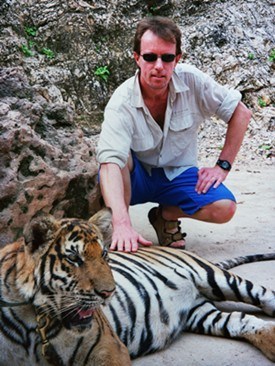
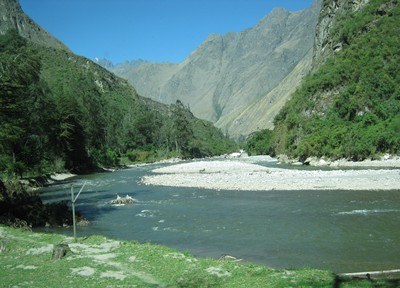
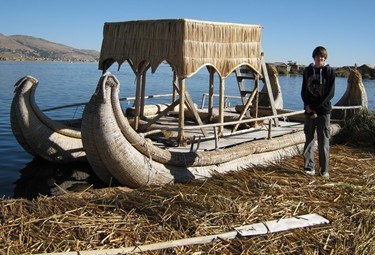
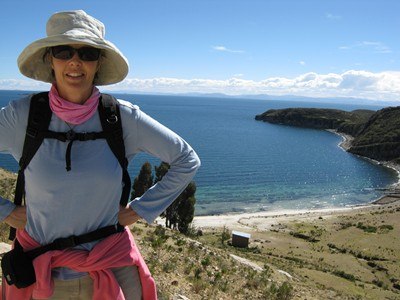
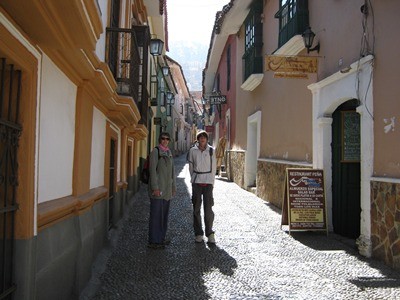

I remember visiting the floating islands when I was in Peru. It was one of the most memorable parts of my trip. Seeing the islands, homes, boats, and everything else made out of the reeds was truly incredible.
I find the floating islands fascinating, and I can’t wait to get there someday myself!